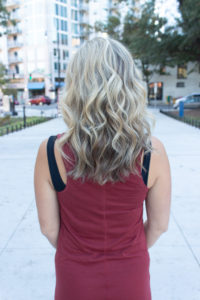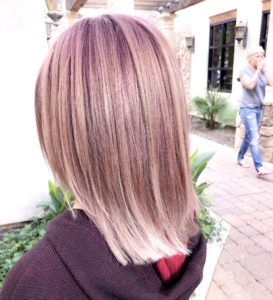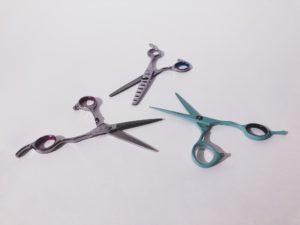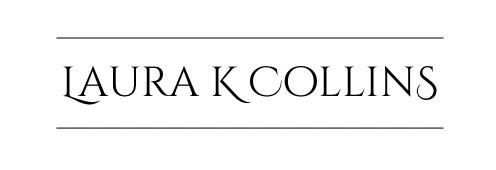How To Differentiate Texturizing, Layers, and Thinning
You’ve heard your hairstylist mention layers, texturizing, or thinning before, but do each of these terms mean the same thing? If not, what is the difference?
They each have a similar meaning, but the hard answer is no they are not the same. And it’s important to recognize the difference.
Layers refer to exterior layers in your hair. This means layers that you can actually see.
Thinning and texturizing refer to interior layers that you can’t physically see in the hair.

What are layers in the hair?
Layers, or exterior layers, are what gives the haircut its shape.
Contrary to popular belief, you cannot count the layers in your hair. So if you go to your hairstylist and ask her for 3 layers, she is probably going to laugh. And if she doesn’t and grabs her shears, RUN!
Layers are cut at angles from where they grow from the head. Long layered cuts are typically cut from 180 degrees from where they grow.
This means they’ll be held straight up in the air from the top of the head, and often times held at 90 degrees from the side of the head to blend with the length of the hair.
Shorter layered cuts are often cut at 90 or 45 degrees. You can see this type of layers in a shag.
Since layers are cut in degrees, you cannot count them. They fall gradually based on where they come from on the head and the degree at which they were cut.
Layers are most often done on wet hair before it is blow-dried, but they can be done on completely dry hair as well.
Even if your hair has no layers and is considered all one length, it can and should still be texturized.

What does texturizing the hair mean?
Texturizing is different from layers in that they are interior and not exterior. This means you typically cannot see where the texture begins and where it ends like you can traditional layers.
Texturizing is the act of removing bulk from specific areas of the hair. If you like wispy bangs, then the mid-ends of the bangs will be texturized to remove bulk and any harsh or blunt lines. This creates the fullness at the root of the hair, and the whispyness at the ends.
To me texturizing is the most important part of a haircut, and I will not let any of my guests leave without allowing me to texturize their hair after cutting it.
Texturizing is done on dry hair, because you cannot see how the hair lays when it is wet. When the hair is dry you can see any weight lines or areas of the cut that have extra bulk or may be lying funny.
The hair may be weighed down in a certain area, or appear poofy where it needs texturized. Interior layers are then cut into the hair where the weight or poof lays until the hair is lying how we want it to.
This allows the hair to look good even after you’ve walked inside from a windstorm. This is what separates a good haircut from a spectacular haircut. It is also why Great Clips haircuts aren’t that great. They don’t always blow-dry the hair and texturize it.
When the hair is texturized it is often much easier to style because it’s been cut to remove bulky areas that may cause problems for styling.
Texturizing can also help the hair either lie under or flip out. If you want the hair to lie under, the underneath pieces need to be texturized create an undercut.
Tools for texturizing hair

Texturizing can be done with regular scissors, thinning shears, notchers, or a feather razor.
When regular scissors are used, the hair may be slide cut or point cut. It will look like your stylist is taking chunks out of your hair, but if she knows what she’s doing, just have faith!
Notchers look like scissors that take serious chunks out of the hair. These are used for blending and heavy texturizing. I like to use these to point cut with especially when I’m cutting bangs or texturizing ends. But if not used properly, these can create harsh lines in the hair.
Thinning shears can be used in place of either regular scissors or notchers, and often times I use all three. They can be a little faster than scissors but also more forgiving than notchers because they have smaller teeth. But again if not done properly, these can also leave lines in the hair.
When a feather razor is used, it should be done on wet hair only to avoid damaging the hair. Some stylists use this tool to remove bulk from a certain area while the hair is still wet.
I prefer not to do this, because I like to see how the hair lays dry first to avoid over texturizing.
What does it mean to thin the hair?
Thinning the hair is closely related to texturizing and is typically done at the same time as texturizing.
The difference between the two is that thinning is removing bulk from ALL of the hair and not certain areas like weight lines.
Thinning will help remove weight from the hair when you have a ton of hair. This can help with styling and even headaches.
When thinning a guests hair I typically start relatively close to the scalp with either my straight shears or my thinning shears and make cuts to remove some of the hair.
I then work my way down to the ends and finish off by texturizing the ends of the hair. You want more bulk towards the root of the hair and less on the ends to achieve maximum volume.
Conclusion
Layers, texturizing, and thinning are similar techniques to remove bulk from the hair, but they are not the same thing.
Layers are exterior cuts and you can physically see where the layers start and end. They are typically done on wet hair but can also be done on a dry haircut. Layers are cut with a straight shear when the hair is held at certain angles from the head.
Texturizing are interior layers that are done to remove bulk from the ends and certain areas to create volume and accentuate a haircut. If hair is not texturized, it will likely become bulky on the ends and lack volume. Texturizing is mostly done on dry hair after the hair has been cut and layered, but it can be texturized while wet as well with a feather razor.
Thinning the hair is the act of removing extra hair when someone has a ton of hair. It is similar to texturizing except it is usually done further up the hair strand closer to the base of the hair than texturizing is. Someone with thin hair will not need their hair thinned, but they will likely still need it texturized.
Hopefully this cleared some things up for you regarding your haircut! If you liked this post, check out my post here to learn the difference between a trim and a haircut! Any other questions for me leave them in the comments. Have a good hair day!



Comments